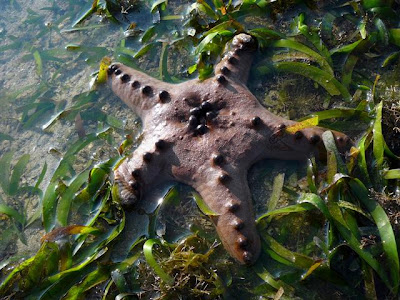Just before the sun decides to peek over the horizon, the intrepid Team Seagrassers were already on the way to "nowhere" as shown in this photograph. We were not heading towards Pulau Bukom (where all the lights come from).
This well lit photograph was taken about half an hour later. Cyrene Reef "pops" put when the tide goes very low. This is a wonderful haven for marine life. I have been eagerly looking forward to revisit after the previous one which left me a deep impression.
We performed our great-yet-longsuffering seagrass transect which took a whooping 50 minutes because there are so many seagrasses at Cyrene Reef (which is a good thing too). I shall focus on the stars of Cyrene on this post, and will continue more the next time.
Cyrene is a place where you die-die can see juvenile knobbly sea star (Protoreaster nodosus) among the lush seagrasses. Of course, that is only possible if the reef does not receive negative impacts from developments or spills.
And yes, all seagrasses were fortunate to find these charismatic stars as they are common in Cyrene. Here's another one that does not look red and is a bit flat. Read the teamseagrass post where they found very small baby knobblies.
As we had just completed our transect, I was looking for more juvenile knobbly sea stars where something red and quite small caught my attention. Wow! This is a first sighting, for me at least. This is a Nepanthia sp., probably Nepanthia belcheri as described in Dr Lane's Sea stars and echinoderms in Singapore BP guidebook.
In that reference, Dr Lane stated that the upper or aboral surface has distinctive cresentic shape of the aboral plates which, with their convex edges appearing to overlap distally, somewhat resembling fish scales. This is true for this particular sea star found today.
Furthermore, Dr Lane mentioned that the arms are almost cylindrical, but with a tapered underside, and they taper slightly to a blunt tip. Shown here is the underside of the beautiful sea star.
Here's comparing the Nepanthia sp. to the knobbly seastar. Big brother to little brother. We are one big family.
Ah huh. Caught in the act of pseudo-copulation are these common sea stars (Archaster typicus). Common sea stars mate with this unique way. The male, which is usually smaller, lies on top of the female, his arms alternating with hers. This is an act of pseudo-copulation because their reproductive organs do not actually have contact but merely release sperm and eggs simultaneously. This might increase the chances of external fertilisation.

Chay Hoon spotted something very very interesting. We all quickly named it as the knobbly-wannabe. It's size and the presence of knobs inspired us to give it such a nickname.

This species is distributed in the Indian Ocean/Red Sea and it inhabits sandy and muddy bottom areas. According to Clark & Rowe (1971), this species is also distributed in SE Arabia. Other places where this seastar can be found include Eastern Africa, Madagascar and Tanzania according to marinespecies.org.
It is possible that this is the first record of this sea star species or even genus in Singapore. Hoorrrray!

According to animal library, Pentaceraster tuberculatus "has a temperature range of 75 to 83°F (24 - 28°C). Grows to about 16 inches (40 cm) in the wild and consumes algae, anemones, gorgonians, soft corals, sponges, clams, urchins, tube worms, and even sleeping fish." Indeed, we can nicknamed this fellow as the evil brother of knobbly sea star since it eats so many animals. Haha.


And of course, how can we identify a sea star without taking the underside? It's underside is as attractive as its upper side, in my opinion. Look at the yellowish bumps and the pink tube feet. Wow!

More about the other non-starry, yet stunning marine life of Cyrene the next round. Watch out for it.
Reference:














4 comments:
Wow... looks like an evil form of our knobbly star. lol
haha indeed does look evil...ma, i cant wait to get out to the shores again!
Found this species, Pentaceraster tuberculatus, on the web.
If this is the one, then indeed it is really evil cos the site said that it consumes algae, anemones, gorgonians, soft corals, sponges, clams, urchins, tube worms, and even SLEEPING FISH! @-@
Yes! This evil looking star is indeed Pentaceraster tuberculatus. Haha. Not only it is evil looking, it is evil in consuming so much marine animals. Hahaha!
Thanks CH for the ID :-)
Post a Comment